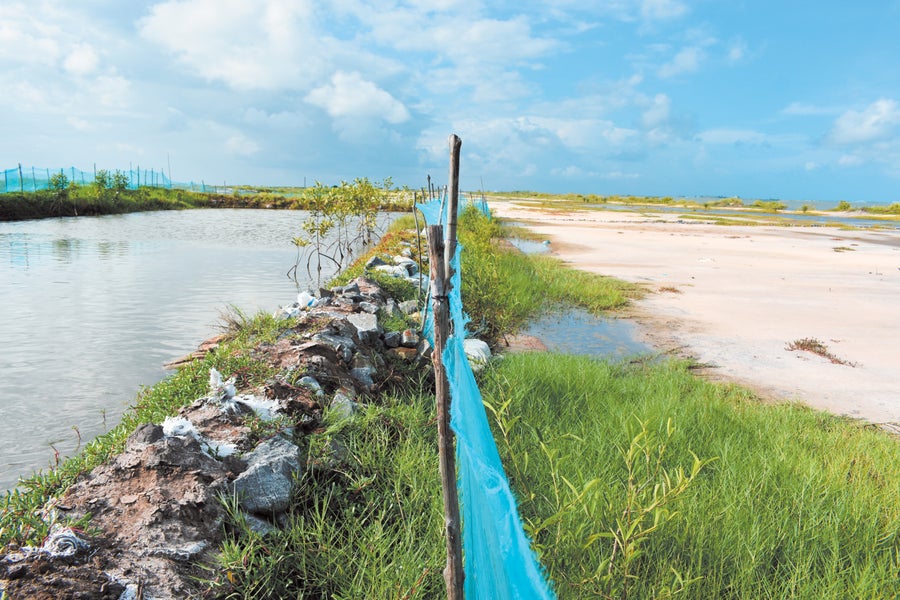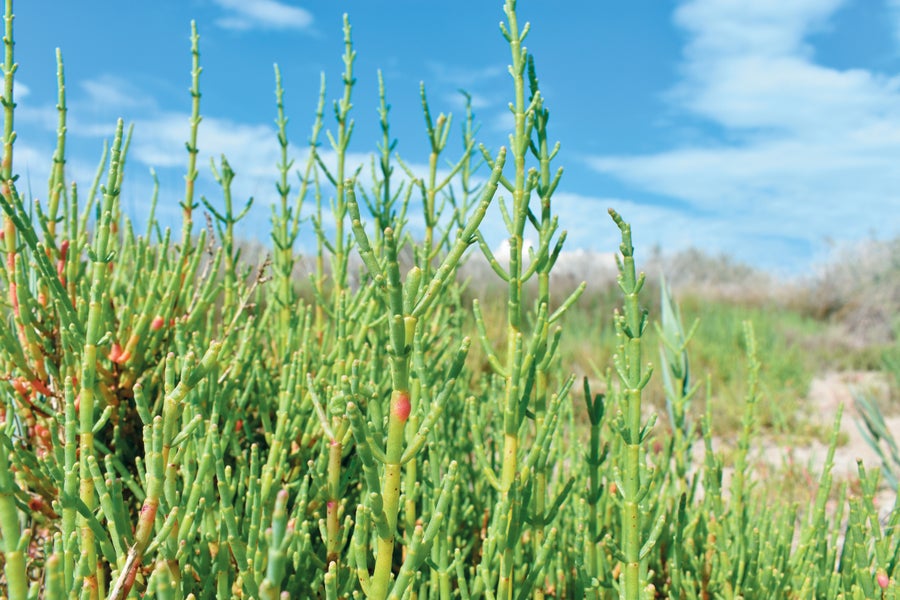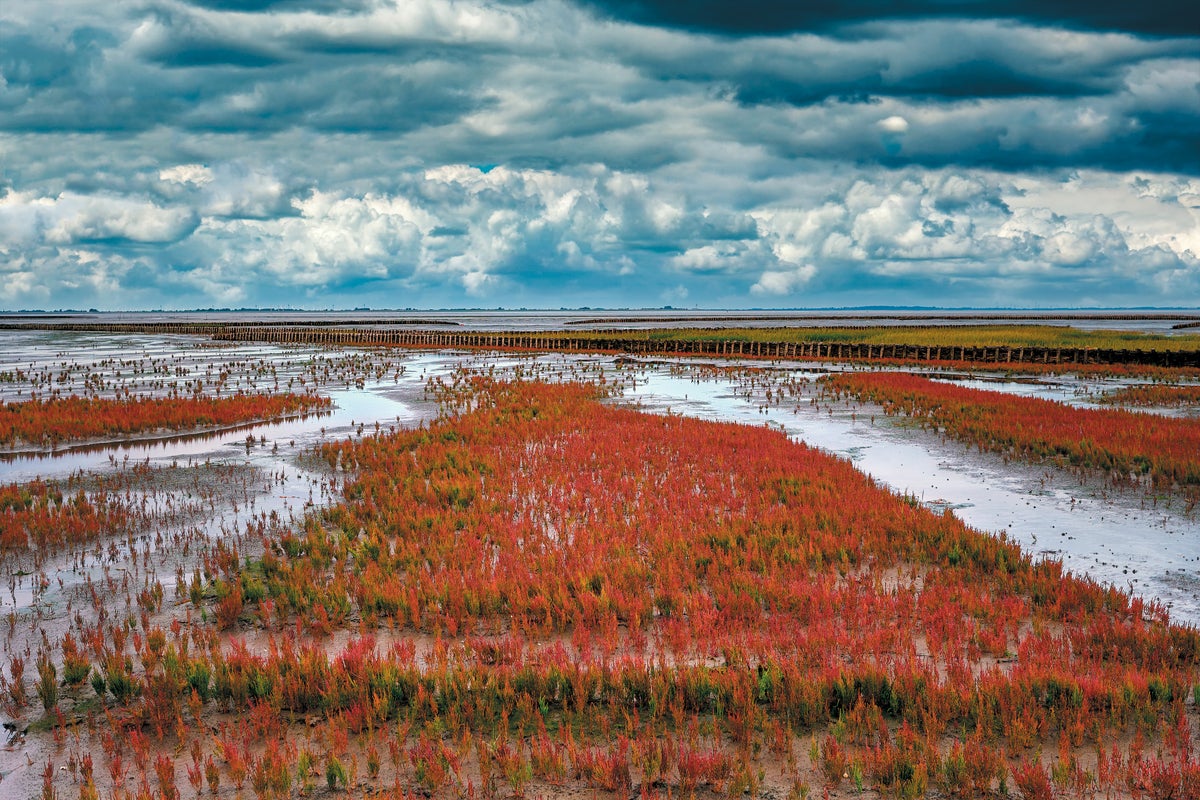This article was produced in partnership with the Pulitzer Center.
Twenty years ago Dutch farmer Hubrecht Janse realized the tide was about to turn on his third-generation family business in the Netherlands. In 2004 the country’s government installed a sluice gate in a dam that separated the glittering blue Lake Veere from the North Sea. An open gate would allow seawater to flow in, reducing damaging algae blooms in the lake’s often stagnant waters. But the connection with the sea would make the lake saltier. “And for us,” Janse says, “that was a problem.”
Janse’s farm—a 160-acre, pancake-flat patchwork of sugar beet, onion, potato, wheat and grass-seed fields—hugs the southern shore of Lake Veere. Saltier water seeping into the soil meant his fields closest to the lake would be rendered useless. Salinity has been an enemy of agriculture for millennia because even though many crops can withstand low to moderate salt concentrations in water and soil, high levels can reduce their yield or outright destroy them by inhibiting osmosis, the process plants use to move water through their tissues.
On supporting science journalism
If you’re enjoying this article, consider supporting our award-winning journalism by subscribing. By purchasing a subscription you are helping to ensure the future of impactful stories about the discoveries and ideas shaping our world today.
Janse wondered whether he could cultivate salicornia, a halophyte—a type of plant that’s native to salty environments. After all, the skinny succulent grew wild, and prolifically, in the area. The plant has a leafless stem resembling a tiny asparagus stalk and a juicy, crunchy texture similar to steamed green beans, with a saltier flavor. Local residents have eaten it raw or cooked for hundreds of years. Janse planted his first crop of Salicornia europaea, sometimes called samphire or sea beans, in 2006. Today the farm also produces ice plant, sea lavender and sea fennel—all halophytes—in addition to more traditional vegetables farther inland. Janse says ice plant is popular; its young, delicate leaves have a spicy, somewhat tangy flavor. Sea lavender’s small, slender leaves are zesty and salty, and people frequently use them in salads. Sea fennel’s succulent stalks and leaves are typically boiled or steamed as a side dish.
There are more than 7,000 edible halophytes in the world. Ancient texts show that people have foraged them for food, medicine and fuel for thousands of years. They appear in the historical record cooked, fermented, pickled and raw. Yet scientists didn’t begin studying their large-scale cultivation potential until the 1960s. The body of research they’ve generated shows that halophytic crops can grow at scale and provide a novel way to shore up food security. The work has also revealed that some halophytes are full of nutrients and chemicals crucial for human health. They are rich in antioxidant and anti-inflammatory compounds, and various species have anticarcinogenic and antimicrobial properties. Some may help lower blood glucose and blood lipids, including cholesterol.
As taste tests prove, people may be ready to eat these foods even if they don’t know it yet.
Janse and other farmers are already selling halophytes to food companies as additives. Janse’s salicornia makes its way into mustard, mayonnaise and caramel as a low-sodium salt substitute. It goes into green pasta, a sparkling tea and gin. And people already eat loads of plants that were natively salt-tolerant at one point in their evolution or still are. Chard and beets come from halophytes originally found wild in saline environments around the Mediterranean. Multibillion-dollar businesses have been built around coconuts and palm dates. Quinoa, a hardy South American halophyte, burst on the food scene more than a decade ago, and today it can be found in grocery stores and restaurants around the world. So researchers say adding more salt-loving plants to the dinner plate isn’t a stretch. “Halophytes are going to be the future for sure,” says Giulia Mozzo, a junior research fellow at the University of Florence in Italy. “Most people don’t realize how big the problem is.”
That problem is a sharp increase in soil salinity across swaths of the planet, exacerbated by climate change. Sea-level rise is pushing salt water farther into coastal farmland; food producers from the U.S. Atlantic seaboard to Bangladesh are fallowing or abandoning coastal farmland because of salt, according to the United Nations Food and Agriculture Organization (FAO). Longer and deeper droughts are a problem, too, because they hasten evaporation, leaving higher concentrations of salty minerals in the soil.
Agricultural irrigation is also driving up soil salinity on inland farms around the world. Irrigation water contains naturally occurring elements—sodium, magnesium, calcium and potassium—that form salts and accumulate in soil over time as the water evaporates again and again. According to the FAO, salinity eliminates up to 3.7 million acres of farmland from production globally every year, and it decreases the yield of nearly 113 million acres a year. Salinity already affects 20 percent of the world’s total cultivated land and 33 percent of its irrigated farmland. Studies predict that the issue will accelerate faster by 2050 because of intensifying drought, which eliminates rains that can dilute salts in the soil, and because of rising temperatures, which exacerbate evaporation. Freshwater deprivation “is going to be one of the major consequences of climate change,” says Ed Barrett-Lennard, a soil-salinity expert at Murdoch University in Perth, Australia.
Jen Christiansen; Source: Tim Flowers/Emeritus Professor in Plant Physiology/University of Sussex (scientific reviewer)
In fields with high salinity and dwindling fresh water, growing halophytes may be the only agricultural alternative. Saltbush, for example, a shrub used in sheep feed in Western Australia, grows in arid, salty environments such as deserts, salt plains, inland marshes and, importantly, irrigated crop land. The feed may be one-third to one-half saltbush, which significantly decreases the volume of freshwater irrigation needed to create sheep food, Barrett-Leonard says.
Ecologists also see broader applications for halophytes because the plants can thrive in harsh ecosystems from the tropics to temperate zones, and they provide a variety of benefits. In marshes, for example, they buffer land from storm surges, hurricanes and sea-level rise, and they also can store massive amounts of carbon. How greatly halophytes benefit the environment will depend on how widely they are consumed—by humans or animals.
One bright, windy afternoon last May, Yanik Nyberg, CEO of NARA Climate Solutions, which is using halophytes to regenerate degraded salt marsh in southwestern Spain, led me along a foot path cut through the company’s vast spread of marsh alongside the Guadalquivir River. It didn’t look like much to my untrained eyes, but Nyberg was clearly delighted with the short, scruffy plants growing everywhere. Only a few months earlier, he told me, the area had looked like a flat wasteland.
He squatted, plucked a dry, weedy specimen out of the ground and invited me to lick it. It tasted like I had emptied a saltshaker into my mouth. The plant, Suaeda maritima, known as sea blite or seepweed, keeps the salt it takes up in its biomass, Nyberg said. The highly salty taste doesn’t really matter, because, along with the rest of the halophytes growing in this formerly barren marsh—“in any given 10 square meters, there’s seven or eight different species growing [wild] together,” Nyberg said—the sea blite isn’t destined for human consumption. NARA harvests the plants, mulches them together and sells the resulting biomass to Halorefine, a Danish company that extracts rich polyphenolic chemicals for use in nutritional supplements and cosmetics. Halorefine then processes what’s left for fish food, which is sold to fish farms, ultimately helping to feed people.

Villagers in Fiaxor, Ghana, have created a fishpond (left) to help feed residents and will grow the halophyte sarcocornia on the adjacent, salty land as fish food. Fish waste will fertilize the plants.
Enormous volumes of fresh water and land are used to grow crops for animal feed. Researchers and farmers around the world are trying to augment animal feed with halophytes grown on marginal land—think degraded coastlines and deserts—that doesn’t compete with prime farmland for freshwater crops. In the U.S., for example, farmers are feeding Distichlis spicata, or salt grass, to cattle.
Nyberg’s plants all around our feet and off into the distance looked like stems coated with hundreds of tiny green flowers because they had already gone to seed. A month prior they were barely seedlings themselves. “That’s how quickly this restoration can take place, without us really having to do anything,” Nyberg said. “It’s in some ways the easiest type of farming, when you just flood a bit of land and let nature do what it does best.”
People around the world are exploiting the natural growth of halophytes in their regions. A few weeks after sampling S. maritima in Spain, I arrived in the Ghanaian village of Fiaxor to visit one such agricultural site, a restoration run by Seawater Solutions, a developer and sister company of NARA. Seawater Solutions invests in wetland-restoration projects on degraded coastal land. Fiaxor clings to the inside rim of a large saltwater lagoon along Ghana’s southeastern coast. The little town is a collection of low, concrete block buildings straddling a narrow spit of flat sand jutting into the deep lagoon. Pygmy goats munch stubby grass that grows in muddy patches between tightly packed houses.
The population of about 300 relies on fishing for its livelihood, which has become so tenuous because of overfishing and excessive algae growth that many young people have moved away. To generate new income, around 2004 the village allowed a salt-mining company to create salt flats at its northeastern end. The hope was to harvest the mineral and earn money from the land lease so the village could cash in on Ghana’s booming, but often exploitative, salt-export business. The process stripped away the island’s protective vegetation, including mangroves. The business folded in 2014, and Fiaxor was left with barren land, making it more vulnerable to storms, flooding and sea-level rise.
Seawater Solutions set up shop in late 2020. Raphael Ahiakpe, the company’s Ghana director, told me that one early idea was to train farmers to grow halophytic crops for human consumption. He then grinned and said residents quickly informed him that his Sarcocornia fruticosa was food for goats, not people. Rather than trying to convince people to eat something they don’t want, Fiaxor is incorporating the sarcocornia, a hardier, perennial version of salicornia, into what the people need: fish feed.
The company now employs several Fiaxor residents and has planted thousands of mangrove saplings on the land the village had leased to the salt company. Next to one stand, Ahiakpe walked me around an artificial fishpond, about 8,600 square feet, where tiny tilapia were growing for the village to harvest when fishing in the saltwater lagoon didn’t net anything. Beside the pond, fronting the lagoon, sarcocornia was about to be transplanted from a plot that’s thriving at the company’s headquarters, about half an hour away.

Salicornia grows thick in a protected salt marsh on Spain’s Mediterranean coast. The succulent stalks can be eaten raw or cooked.
Fish effluent from the pond will fertilize the halophytes, and the halophytes will feed the fish; their seeds make a protein- and oil-rich fish meal. The village is making money by leasing the land to the company. And Seawater Solutions has received accreditation from an organization to sell carbon credits for the root-level carbon sequestration that the sarcocornia and mangroves will provide. The company says it splits the income with the village.
Doris Atitsogbui, the site manager and a lifelong resident, told me the village was “happy and excited” when Seawater Solutions proposed its project because there were no jobs in Fiaxor. She’d like to see similar sites spread throughout the Volta Delta region, which is teeming with hundreds of other fishing villages. The salty plants could help solve a variety of societal challenges.
The science of halophytes is also being applied to traditional crops. Researchers at King Abdullah University of Science and Technology in Saudi Arabia grew cultivars of the currant tomato, a small, wild relative of the common tomato that thrives in Peru, and found five cultivars that did well in highly salty environments. The scientists are investigating genes in those varieties that they could breed into other tomatoes. Researchers at the University of California, Davis, are trying to devise transgenic alfalfa, pearl millet, peanuts and rice that will grow in salty conditions.
Yet there are still plenty of obstacles. Some halophytes produce oxalic acid, which is toxic to the kidneys when eaten in large amounts. Many of the plants are “includer” halophytes, meaning they absorb sodium from their environment. This trait makes them high-salt foods, which can be a concern for people with high blood pressure. (“Excluder” halophytes can deal with salty environments by blocking sodium from entering their roots.) Agronomists have learned, though, that sodium levels in many of the harvested crops can be reduced significantly through cooking.
Growing the crops also can be tricky because many still need some amount of fresh water. Salicornia, for example, needs lower salinity to germinate in the spring. “What I say to other farmers in my region,” Janse explains, “is that the availability of fresh water at the right moment is even more important than for fresh crops.”
Perhaps the biggest challenge for farmers, according to Janse, is that demand for halophytes is low outside regions like his. Most people have never heard of them. If the foods are around at all, they tend to be grown on small farms and be offered in upscale supermarkets or restaurants—an irony not lost on advocates who argue that adding more halophytes to the global diet could tackle hunger and food insecurity in low-income countries.
To raise public awareness, some agronomists have become test-kitchen chefs, realizing that if the vegetables are to spread, people need to try them. What the proponents are finding is that the more consumers know about the environmental impacts of agriculture, the more open they are to halophytes. In March 2024 a team at the University of Florence ran a small, qualitative study to assess the viability of Tetragonia tetragonioides, a species of dark, leafy green halophyte, as an alternative to spinach. Spinach is relatively salt-tolerant, but tetragonia can be reliably cultivated in a greenhouse at a much higher ratio of salt to fresh water—up to about twice what spinach can handle.
Participants were not told how the plant was grown before they ate it. A small percentage of them said they would pay more for tetragonia than spinach simply because they preferred it. But that percentage nearly tripled when the people were told tetragonia was grown sustainably with less fresh water. (The study results have not yet been published.) It’s easy for people to say they would act a certain way, says Mozzo, who worked on the study, but the outcome supports the idea that people can be sold on these plants. Halophyte evangelists like to remind listeners that prior to the 2010s, few consumers outside of South America knew quinoa. Then, in 2013, the U.N. declared the International Year of Quinoa and funded an awareness campaign targeting farmers and consumers.
Still, agricultural policies may present “bottlenecks and obstacles” to broader uptake of halophyte farming, says Kate Negacz, a saline-agriculture policy researcher at Vrije University in Amsterdam. In many countries or states, governments pay subsidies primarily for conventional crops; if a subsidized corn farmer wanted to switch to ice plant because salty water was seeping into her land, she’d be unlikely to get a subsidy for it. And in many jurisdictions, water use is controlled by local water boards, which would need to be convinced that halophytes are viable. Some hope may come from Europe, where policy conversations related to saline-agriculture practices are becoming more frequent. “Things are starting to move,” Negacz says.
In Ghana, as in the Netherlands and Spain, the lesson for researchers, entrepreneurs and farmers is that halophytes work when they fit cultural and economic needs. In the Netherlands, Janse says, it’s normal to see halophytes on the dinner plate. In Ghana, the plants serve a different but no less important function, providing fish food and local income.
In an increasingly salty world, there is an urgent need for diverse applications of these plants. Agronomists, soil scientists and ecologists on almost every continent are working to address agricultural salinization, and halophytes already grow in a wide array of climates. And as the participants in the University of Florence taste test of tetragonia proved, people may be ready to eat these foods even if they don’t know it yet.

